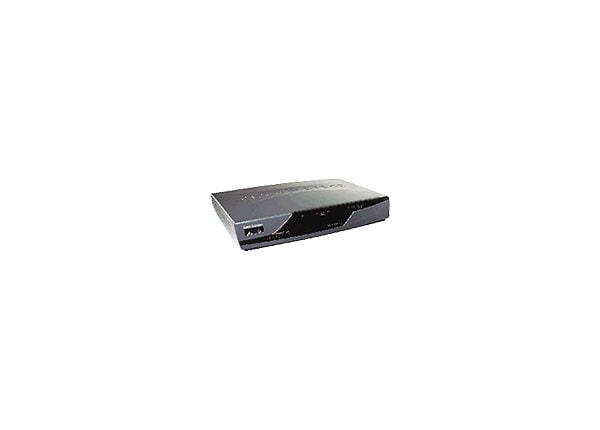
Know your gear
High performance for broadband access in small offices
The Cisco® 870 Series Integrated Services Routers extend the high-performance Cisco Integrated Services Router capabilities of running secure concurrent services, including firewall, VPNs, and WLANs, at broadband speeds to small offices. Easy deployment and centralized management features enable the Cisco 870 Series to be deployed in small office or teleworker sites as part of an enterprise network, by small to medium business customers for secure WAN and WLAN connectivity, or used by service providers to offer business-class broadband and WLAN services.
Cisco 870 Series of integrated services routers are fixed-configuration routers that support multiple types of DSL technologies, broadband cable, and Metro Ethernet connections in small offices. They provide the performance needed to run concurrent services, including firewall, intrusion prevention, and encryption for VPNs; optional 802.11b/g for WLAN networking; and quality of service (QoS) features for optimizing voice and video applications. In addition, the Cisco Router and Security Device Manager (SDM) Web-based configuration tool simplifies setup and deployment, and centralized management capabilities give network managers visibility and control of the network configurations at the remote site.
The Cisco 870 Series is ideal for small remote offices and teleworkers that need to be connected to larger enterprise networks. When extending corporate networks to numerous remote sites, network resources must remain secure while giving users access to the same applications found in a corporate office. This applies to both data and voice applications, where IP phones can be used to extend a corporate voice extension to the remote office. When users require WLAN access, visibility and control of network security is even more critical at the remote site.
Routing Protocols and General Router Features:
• Routing Information Protocol (RIPv1 and RIPv2)
• Layer 2 Tunneling Protocol (L2TP)
• Cisco Express Forwarding (CEF) Port Address Translation (PAT)
• RFC 1483/2684
• Point-to-Point Protocol over ATM (PPoA) (DSL models only)
• PPP over Ethernet (PPPoE)
• 802.1d Spanning Tree Protocol (STP)
• Dynamic Host Control Protocol (DHCP) server/relay/client
• Access control lists (ACLs)
• Generic routing encapsulation (GRE)
IPv6 Features:
• IPv6 addressing architecture
• IPv6 name resolution
• IPv6 statistics
• IPv6 translation-transport packets between IPv6-only and IPv4-only endpoints
• ICMPv6
• IPv6 DHCP
Security Features:
• Stateful Inspection Firewall
• Bridging firewall (Cisco 871 only)
• NAT transparency
• Firewall support for skinny clients
• Hardware-accelerated 3DES for IPSec
• Hardware-accelerated AES for IPSec
• Cisco Easy VPN Client and Server
• IPSec 3DES termination/initiation
• IPSec passthrough
• Point-to-Point Tunneling Protocol (PPTP) passthrough
• L2TP passthrough
• 802.1X
• Secure HTTP (HTTPS), FTP, and Telnet authentication proxies
Management Features:
• Cisco SDM
• Management of LAN switch ports
• Cisco Configuration Express
• Cisco CNS 2100 Intelligence Engine support
• DSL firmware update from Flash
• Cisco Service Assurance Agent (SAA)
• Telnet, Simple Network Management Protocol (SNMP), CLI, and HTTP management
• RADIUS and TACACS+
Cisco 870 Series of integrated services routers are fixed-configuration routers that support multiple types of DSL technologies, broadband cable, and Metro Ethernet connections in small offices. They provide the performance needed to run concurrent services, including firewall, intrusion prevention, and encryption for VPNs; optional 802.11b/g for WLAN networking; and quality of service (QoS) features for optimizing voice and video applications. In addition, the Cisco Router and Security Device Manager (SDM) Web-based configuration tool simplifies setup and deployment, and centralized management capabilities give network managers visibility and control of the network configurations at the remote site.
The Cisco 870 Series is ideal for small remote offices and teleworkers that need to be connected to larger enterprise networks. When extending corporate networks to numerous remote sites, network resources must remain secure while giving users access to the same applications found in a corporate office. This applies to both data and voice applications, where IP phones can be used to extend a corporate voice extension to the remote office. When users require WLAN access, visibility and control of network security is even more critical at the remote site.
Routing Protocols and General Router Features:
• Routing Information Protocol (RIPv1 and RIPv2)
• Layer 2 Tunneling Protocol (L2TP)
• Cisco Express Forwarding (CEF) Port Address Translation (PAT)
• RFC 1483/2684
• Point-to-Point Protocol over ATM (PPoA) (DSL models only)
• PPP over Ethernet (PPPoE)
• 802.1d Spanning Tree Protocol (STP)
• Dynamic Host Control Protocol (DHCP) server/relay/client
• Access control lists (ACLs)
• Generic routing encapsulation (GRE)
IPv6 Features:
• IPv6 addressing architecture
• IPv6 name resolution
• IPv6 statistics
• IPv6 translation-transport packets between IPv6-only and IPv4-only endpoints
• ICMPv6
• IPv6 DHCP
Security Features:
• Stateful Inspection Firewall
• Bridging firewall (Cisco 871 only)
• NAT transparency
• Firewall support for skinny clients
• Hardware-accelerated 3DES for IPSec
• Hardware-accelerated AES for IPSec
• Cisco Easy VPN Client and Server
• IPSec 3DES termination/initiation
• IPSec passthrough
• Point-to-Point Tunneling Protocol (PPTP) passthrough
• L2TP passthrough
• 802.1X
• Secure HTTP (HTTPS), FTP, and Telnet authentication proxies
Management Features:
• Cisco SDM
• Management of LAN switch ports
• Cisco Configuration Express
• Cisco CNS 2100 Intelligence Engine support
• DSL firmware update from Flash
• Cisco Service Assurance Agent (SAA)
• Telnet, Simple Network Management Protocol (SNMP), CLI, and HTTP management
• RADIUS and TACACS+
